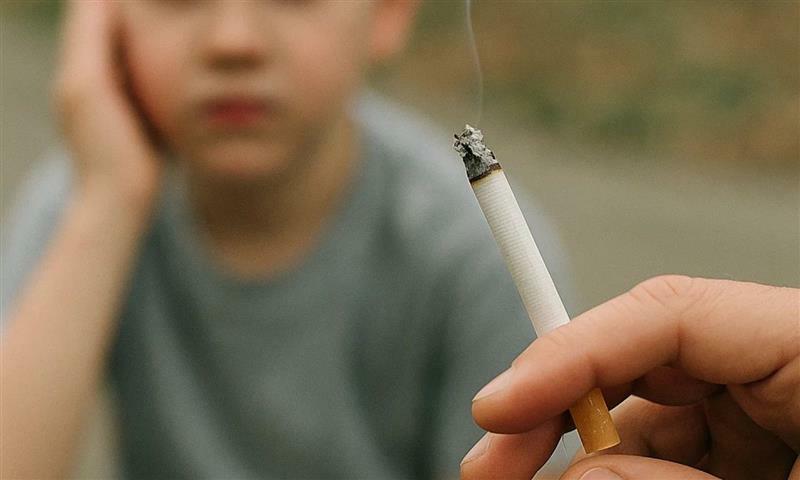
Enab Baladi – Raghad Othman
The phenomenon of smoking among children is one of the most serious and influential societal issues, particularly affecting children psychologically and physically. It has become more widespread due to the worsening economic and social crises that Syria has witnessed in recent years. Easy access to cigarettes, the absence of family supervision, and the lack of effective awareness campaigns are all factors that have influenced the scale of this phenomenon and its repercussions on society.
Desire to Imitate
“He became more irritable, his mood changed frequently, and problems with his siblings began to increase—until I smelled smoke on his clothes more than once. Then I later found a cigarette hidden on the shelf of his wardrobe.”
With these words, Rula, a government employee and mother of three, recounts how she discovered that her ten-year-old son had tried smoking.
Despite her shock, she chose to remain calm and avoid reacting harshly. Instead, she decided to speak to her son, Karam, calmly to understand why he tried smoking, as she told Enab Baladi.
She said, “He confessed quite innocently that he had tried it out of curiosity and a desire to imitate his friends, thinking it was a sign of maturity.”
Rula consulted a psychological counselor who helped her devise a thoughtful plan to handle the situation wisely. The plan centered on getting closer to her child, monitoring him, giving him a space of trust, and engaging him in beneficial sports activities.
She added that the process required time and follow-up, but eventually, Karam realized the dangers of this behavior and became convinced of its harm.
Psychological Causes and Motives
Smoking among children is considered a serious indicator of various behaviors tied to parenting style and the child’s environment, according to psychological counselor Alaa Rankoussi, who spoke to Enab Baladi.
Rankoussi pointed out that the child’s environment is the primary factor fostering this negative behavior. A child raised in a household where smoking is common is more likely to imitate it. Children are natural observers and tend to associate smoking with traits like maturity or masculinity, or view it as a way to express anger, making the experience easier for them compared to others.
In some cases, smoking stems from imitating what children see in the media or as an attempt to assert their identity, express rebellion, explore, or escape psychological pressures.
Regarding how to deal with a child who smokes, Rankoussi believes that a calm dialogue based on understanding and emotional support is the most effective approach. It’s important to avoid punishment or direct scolding. Children should be educated about the dangers and health effects of smoking through storytelling and targeted awareness videos, as well as through offering rewards and enrolling them in sports or cultural activities that strengthen their interest in their own well-being.
Health Impact
Pediatric specialist Dr. Bushra Khreita told Enab Baladi that the increasing prevalence of smoking among children and adolescents has become a “frightening” phenomenon for this age group. The harm to children is greater than to adults because their organs are still developing, making them more vulnerable to toxic and carcinogenic substances.
She added that smoking’s negative impact on children’s health is not limited to the long term but also appears in the short term—such as frequent coughing, shortness of breath, low physical endurance, rapid heartbeat, high blood pressure, and poor concentration and attention.
Regarding illnesses that affect children who smoke, Bushra explained that they are more susceptible to neurological disorders, heart disease, and blood vessel constriction. They may also suffer from respiratory conditions like asthma or worsening asthma if genetic factors are present—bronchitis, pneumonia, as well as digestive issues like acid reflux, weakened immunity, tooth decay, and gum inflammation.
In terms of treatment, Dr. Khreita noted that intervention focuses more on psychological and behavioral aspects than on medication. For example, using reward systems to encourage the child. Medically, nicotine replacement products (such as patches or gum) may be used if deemed appropriate for adolescents.
She concluded that quitting smoking is possible for children through a comprehensive treatment plan that includes awareness, psychological support, and medical care.
Importance of Family and Community Awareness
The danger of the issue does not stop at smoking, according to social expert Ghadir al-Najjar, who said this behavior opens the door to even more dangerous practices, such as drug use and behavioral deviations, endangering the child’s future—especially in the absence of family monitoring or when changes in the child’s behavior at sensitive developmental stages are ignored.
She said that a conscious family, capable of understanding the risks of negative behaviors, is the only one able to protect its children and shield them mentally and physically. Meanwhile, traditional, inherited parenting styles often produce psychologically fragile children who are more susceptible to the dangers of smoking and other behavioral disorders.
As for the role of educational and social institutions in limiting the smoking phenomenon, the expert emphasized that the family’s role cannot be separated from that of schools, the media, and cultural and religious institutions. These institutions must work to raise awareness among children and families about the dangers of smoking through educational programs, direct discussions, awareness bulletins, and social media—ultimately boosting societal awareness and curbing the spread of this dangerous phenomenon.
The post Warnings About the Phenomenon of Child Smoking in Syria appeared first on Enab Baladi.
